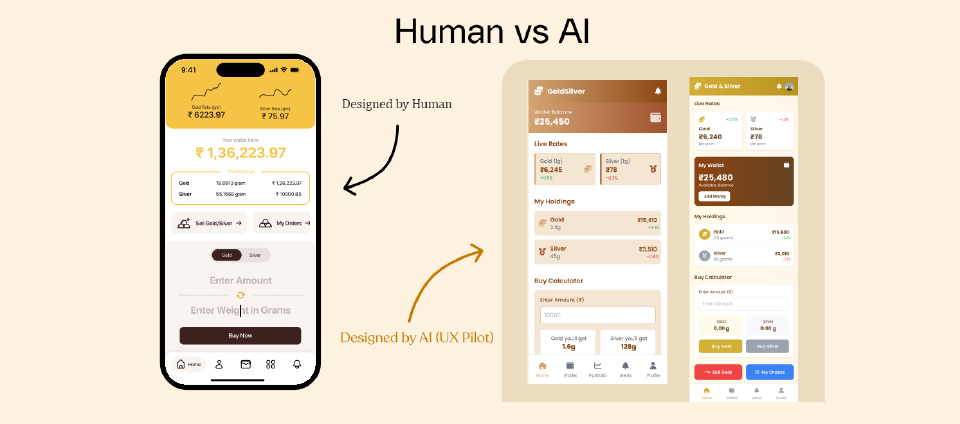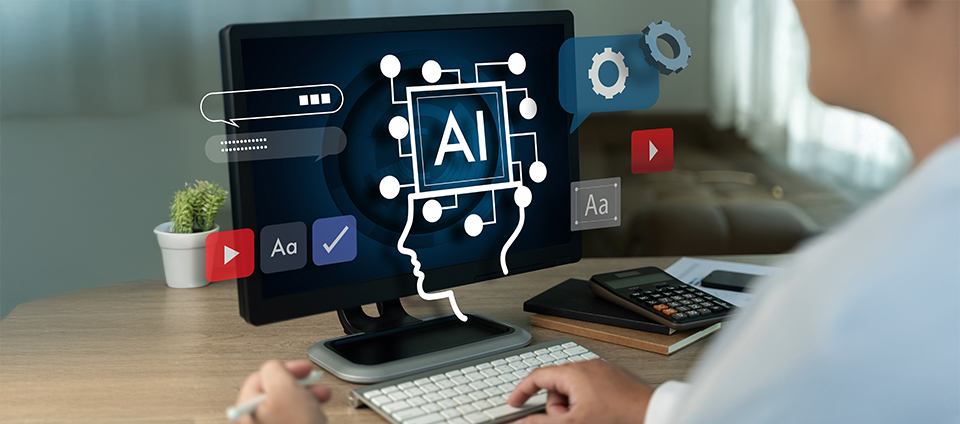Will AI Replace Creative Designers?
The question of whether artificial intelligence (AI) will replace creative designers has become one of the most debated topics in the design and technology world. With rapid advances in AI in design tools like MidJourney, Figma AI, Canva Magic Design, and ChatGPT, it’s clear that AI is reshaping workflows. But does this mean creative designers will be out of the picture? Or will AI and humans evolve as collaborators in creating compelling digital experiences?
Let’s explore the balance between what AI can deliver today, what it cannot replace, and why the future of design belongs to the combined strengths of human creativity and machine intelligence.
Human vs. AI: Comparing Capabilities
The design experiments showcased in the figure below highlight the contrasting outputs between human designers and AI-driven tools. For example, side-by-side comparisons of mobile app screens, one created by a human designer and another by AI, demonstrate how close AI has come to replicating functional and visually appealing layouts.

The AI-generated versions captured essential elements like live rates, wallet balances, and transactional details while applying requested design themes such as mustard yellow and brown color combinations. At the same time, the human-designed screens reflected deeper creativity, storytelling, and user empathy.
This comparison makes one thing clear: while AI can replicate, reimagine, and automate, the human touch still brings unmatched originality and context.
What AI Can Do

AI has proven incredibly effective in automating repetitive design tasks. For example:
- Resizing assets for different platforms.
- Drafting wireframes for mobile or web layouts.
- Generating quick variations of content and imagery.
Tools like Figma AI, Canva Magic Design, Runway, and ChatGPT can produce logos, ad creatives, or even UI UX prototypes in minutes. This significantly reduces design timelines and allows creative teams to focus on more strategic initiatives.
In short, AI excels at speed, automation, and ideation. It thrives when the requirements are clearly defined and outcomes are task-oriented.
What AI Can’t Replace
Despite its impressive abilities, AI has limits that define why human designers remain indispensable. True design goes beyond shapes and layouts, it is about understanding people.
Human creativity is fueled by emotional intelligence, cultural awareness, and deep insights into user psychology. Designers also craft narratives that give brands identity and meaning, something algorithms cannot replicate with authenticity. Empathy, collaboration, and ethical judgment are uniquely human strengths that AI lacks.
This distinction makes it clear: AI may generate drafts, but only humans can create designs that connect emotionally and culturally.
The Future: AI + Designers Together

Instead of asking if AI will replace designers, the better question is how expert UI UX designers can use AI as a partner. The future is not about competition but collaboration.
Designers will continue to act as strategists and problem solvers, bringing innovation, ethics, and empathy into their work. Meanwhile, AI will act as a tool - handling speed, automation, and idea generation. Together, this partnership ensures better efficiency without sacrificing originality.
This “co-creator” model redefines workflows. Designers who embrace AI will gain supercharged creative capacity, faster prototyping, and the ability to focus on higher-value storytelling and user-centered innovation.
Designers as Co-Creators, Not Replacements
The conclusion is simple yet powerful: AI is a co-creator, not a replacement. By augmenting human creativity with automation and speed, organizations can achieve better outcomes, stronger user experiences, and more engaging brand identities.
Embracing AI while championing human creativity is the winning formula. It’s about striking the right balance: empowering designers with tools that free them from repetitive work while allowing them to lean into their strengths of empathy, culture, and strategy.
Why This Matters for Businesses
For businesses and clients, the key takeaway is reassurance. Creative designers are not going away; rather, their roles are evolving. By pairing AI design tools with skilled human designers, companies can build digital products and campaigns that are not only faster to market but also deeply resonant with users.
AI ensures efficiency, scalability, and rapid iteration. Designers ensure creativity, authenticity, and human connection. Together, they deliver digital solutions that enhance customer experiences while staying aligned with brand values.
Conclusion
So, will AI replace creative designers? The evidence suggests otherwise. While AI will continue to evolve and automate many aspects of design production, it cannot replicate the human ability to innovate, empathize, and tell stories that matter.
The future of design is about AI plus designers together. A UI UX design company that embraces this hybrid approach will achieve the best of both worlds - efficiency and originality, speed and strategy, automation and empathy.
For design teams and beyond, this is both a challenge and an opportunity: to stay adaptable, harness AI’s strengths, and never lose sight of the human heart of design.



